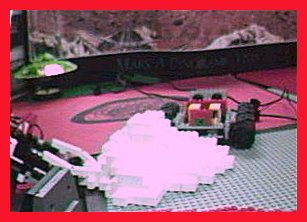
Mars Virtual Space Camp 2

Virtual Space Camp 2 Red Rover Goes to Mars
Students at Virtual Space Camp 2 for Mars Millennium and Red Rover Goes to Mars worked an entire day imagining what it would be like for a community to work and live together on Mars in 2030. Rovers were made to do remote work on the areas not under climate control.7 "Days" of Mars Virtual Space Camp
The mission specialists of the Virtual Mars Space Camp 2 worked together for seven hours, which we described as seven "virtual days," planning and building a Mars Colony Complex and MarsScape. These were built in order to serve as a setting for operation of the Red Rover, to provide experience in remote teleoperation of a vehicle to students interested in applying to the Red Rover Goes to Mars project.Each hour, or virtual day, was spent following a structured schedule. Students discussed what might have happened over the course of that day in the Mars Colony Complex, as inhabitants worked in research and construction of buildings, equipment, and vehicles. Objectives included provision of food, water, air, living quarters, and protection from radioactivity. Outside of the Complex structure itself the surrounding landscape of the planet was constructed, where the camera-equipped Rover was to conduct observation and gathering of samples.
After the planning of activities, the actual construction began, first of the structures needed for survival, then of equipment needed to begin exploration, scientific research, and gathering of materials for further construction. Each day ended with each individual making a ten-minute journal entry, in order to record the virtual day's accomplishments as a community.
When asked what five things they would bring with them to Mars, the students began to realize what they took for granted in their lives on Earth. Many felt animal companions were a necessity, and others assumed that of course computers would have to be taken, not only for research and support to communication and basic survival, but also for entertainment, creative outlets, and personal communication. The community as a whole would also need essentials like solar panels for a power source, seedlings and containers for sustaining and sustainable agriculture, and living space during the trip and then during construction of more permanent life support.
Mission specialists, members of the virtual community, sorted themselves by aptitude into positions of specialization needed in the micro-society. Computer programmers were needed to operate robotic arms on landers, used in construction and gathering of materials and samples, which followed the construction of the arm itself. Doctors were needed to maintain and mend the health and well-being of community members. Specialists focused on greenhouse construction and tending of food plants. Other construction projects included houses, the radiation shield dome itself, hydroponics systems, and water-extraction plants to recover the small amount of water available in rock-bound ice crystals.
All specialists contributed in the manual labor essential to all stages
of construction. This virtual labor by virtual colonists was represented
by the students' LEGO design and assembly.
Mission Specialists
Mission Specialists were students grade 3 to 6 from the schools in West Virginia around Marshall University that liked to work with LEGO and learn about Mars.Mars Millennium and Red Rover Goes to Mars
Description Virtual Space CampPictures of Virtual Space Camp 2
LEGO Links of Linda Hamilton
published May 18, 2000